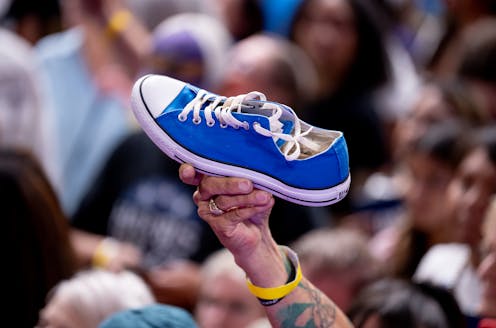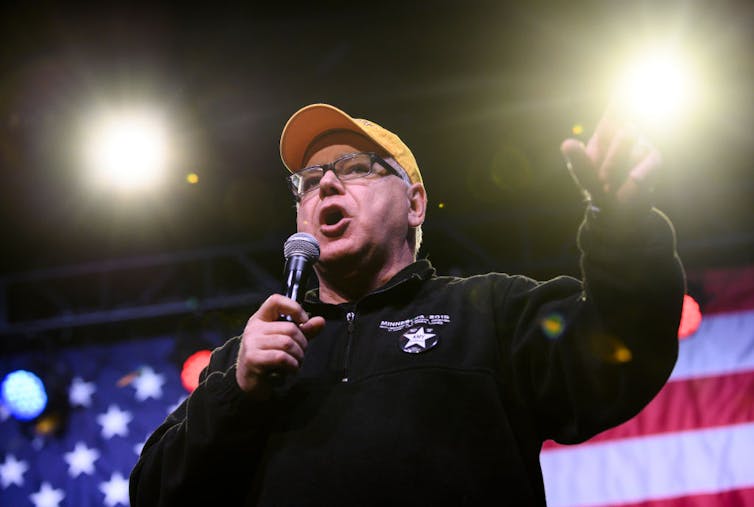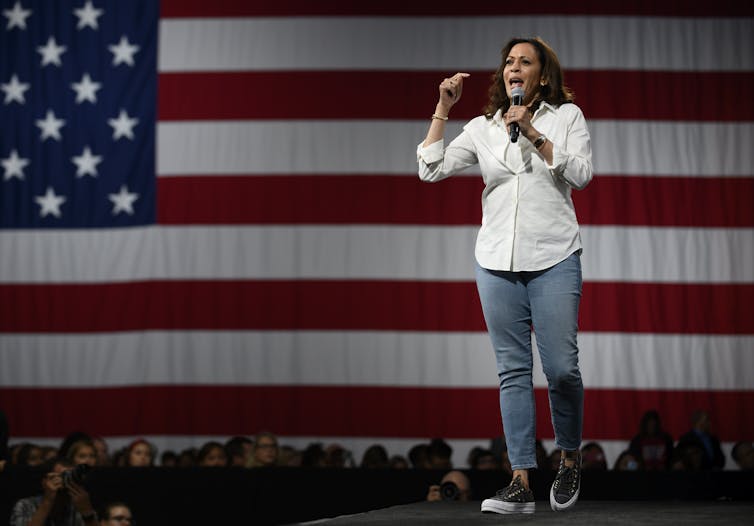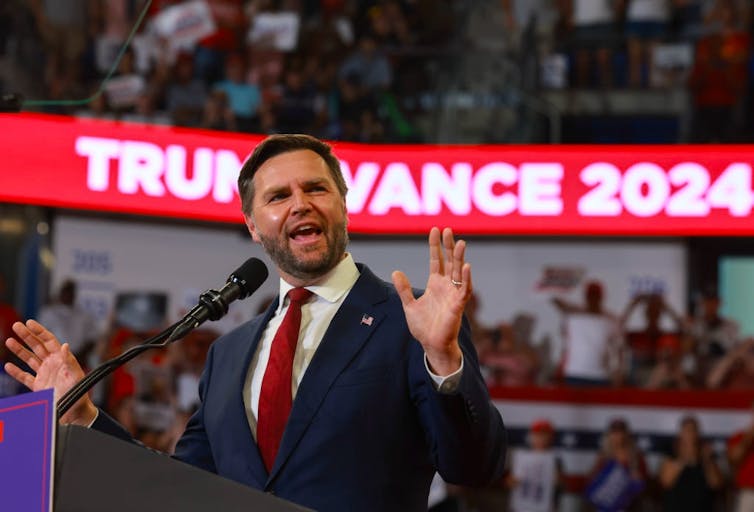Kamala’s kicks, Tim’s lids, and the red ties that bind Trump and Vance – what’s behind the fashion choices of each candidate
- Written by Deirdre Clemente, Associate Professor of History, University of Nevada, Las Vegas
 A man holds up a Converse Chuck Taylor – Kamala Harris' favorite footwear – during the vice president's campaign rally on Aug. 9, 2024, in Glendale, Ariz.Andrew Harnik/Getty Images
A man holds up a Converse Chuck Taylor – Kamala Harris' favorite footwear – during the vice president's campaign rally on Aug. 9, 2024, in Glendale, Ariz.Andrew Harnik/Getty ImagesWith Election Day approaching, candidates are courting voters with everything they’ve got: targeted ads, texts, taunts and stump speeches.
As a fashion historian, I think an overlooked aspect of electioneering is clothing, which is a silent, powerful way for candidates to tell the American public who they are.
It’s an act as old as power itself.
“Clothes, from the King’s mantle downwards, are emblematic,” wrote Scottish philosopher Thomas Carlyle in “Sartor Resartus,” a seminal text in fashion studies.
Tim Walz, Kamala Harris, JD Vance and Donald Trump have all taken a page from that 1834 publication. Each wields an emblem in an effort to appeal to voters – and hint at how they’ll lead.
The people’s crown
What’s more American than a baseball cap?
When Tim Walz, the Democratic vice presidential candidate, dons one on the campaign trail, he’s doing more than covering up a thinning head of hair.
To the bane of many churchgoers and office managers, baseball caps have moved beyond the ballpark to become a ubiquitous symbol for an American dude.
“It’s completely egalitarian,” surmised a brand guru at New Era, the official baseball cap supplier of Major League Baseball. “It’s the people’s crown.”
 Minnesota Gov. Tim Walz speaks at a campaign rally in Minneapolis in January 2020.Stephen Maturen/Getty Images
Minnesota Gov. Tim Walz speaks at a campaign rally in Minneapolis in January 2020.Stephen Maturen/Getty ImagesThe baseball cap is born of functionality. Shaded eyes can see better. In the 1880s, ballplayers chose among styles ranging from bellman-inspired, stout-brimmed pillboxes to something newsboys might wear. Consumers’ choices pushed manufacturers such as Spalding to settle on the domed design used today.
I think Walz wears the hats to tell voters, “Hey, I’m just like you.”
He has a cap for every occasion. The former high school coach wears a mesh-sided, truckers’ hat to host a fishing competition. He sports a camouflaged number when talking to fellow hunters. He changes to an NFL Minnesota Vikings version when eating corn dogs with journalists, and another one featuring Goldy Gopher – the mascot of the University of Minnesota – when he’s embracing piglets at the state fair.
Smooth moves
Whether she’s dancing to the beat of a drum line or flipping burgers, presidential candidate Kamala Harris can usually be seen wearing a classic pair of Chuck Taylor All-Stars.
Marquis Mills Converse designed the sneaker at his Massachusetts-based, rubber shoe company in 1917 in an attempt to appeal to athletes playing basketball, a relatively new sport that was booming in popularity. The shoe’s diagonal-tread soles prevented players from slipping on the basketball courts that were appearing on college campuses and in cities across the country.
Today, you can’t overstate the cultural clout of Chuck Taylor All-Stars.
Fashion historians say the shoe’s democratic origins – at one point, it commanded over 70% of the basketball shoe market – are part of its continued appeal. The company’s archivist attributes its success to its utilitarian simplicity.
But in the 1970s, the ascendant Adidas Superstar, which were lighter with protective shell toes, became the favorite of basketball players.
No matter. California skateboarders fell in love with the All-Star’s soles, which allowed for extra grip on their decks. So it’s somewhat fitting that a politician from California made the shoe a part of her signature style.
The low-cut model that Harris wears was introduced for a nonsports market in the 1950s, and she’s raved about their practicality and versatility.
 Kamala Harris wears her Chuck Taylor All-Stars during a campaign event in 2019.Stephen Maturen/Getty Images
Kamala Harris wears her Chuck Taylor All-Stars during a campaign event in 2019.Stephen Maturen/Getty Images“I run through airports in my Converse sneakers,” she told The Cut, an online fashion publication, in 2017. “I have a whole collection … a black leather pair, a white pair, I have the kind that don’t lace, the kind that do lace.”
She wore the shoes on the cover of Vogue magazine in 2021, and they’ve been a constant presence as she runs for the top job.
Beyond the comfort the sneakers offer for a candidate who’s often on her feet, I think they send a subtler message that hearken back to their origins: ready to move, ready to pivot, ready to win.
Imitation is flattery
A red tie is nothing new. For centuries, military leaders and their armies used red neckwear to project power and aggression. Chinese imperial warriors wore red bandannas. To match the color of the emperor Trajan’s cape, Roman soldiers sported red kerchiefs.
Former president Trump has worn a red tie since the early 1980s, when he was mainly known as a ruthless real estate mogul. As president, he doubled down on “Republican Red.”
Though long associated with dominance and fervor, red only became the color of the GOP within the past several decades, after television stations assigned the party the color to convey state-by-state election results.
As Oscar Wilde wrote, “Imitation is the sincerest form of flattery,” and Trump’s followers cribbed his sartorial style.
You can count Vance among them. The Republican vice presidential candidate’s adoption of the red tie is the cherry on top of his transformation from tech bro to MAGA acolyte.
 By wearing a red tie, GOP vice presidential hopeful JD Vance is taking a page from his boss’s getup.Joe Raedle/Getty Images
By wearing a red tie, GOP vice presidential hopeful JD Vance is taking a page from his boss’s getup.Joe Raedle/Getty ImagesAs menswear expert Derek Guy has written, Vance underwent a glow-up on his way to becoming the vice presidential nominee. Gone were the off-the-rack, gray suit jackets paired with open-neck, button-down collar shirts and nice jeans.
In their place, the uniform of his new boss: navy blue suits, worn with the more formal, spread collars – and yes, shiny, red ties.
Guy sees Vance’s makeover as “a sartorial mea culpa, a way for him to walk back his previous criticisms and prove his loyalty to Trump.”
Vance’s suits are better fitting that Trump’s, and his ties knotted a tad more loose. But the message is the same as it has been for millenia: “I’m the guy in the room who runs this army.”
Well, as long as Trump isn’t around.
Orange crush
Trump blames the orange hue of his skin on energy-efficient light bulbs, but there’s more to it than that.
Likened by The New York Times to “Warhol’s shock of white hair or Big Bird’s scarlet plumage,” Trump’s faux tan has been “a culturally embedded representation of him long before he entered politics.” The look has been picked apart by beauty editors, shaded by cartoonists and relentlessly ridiculed by his critics.
And yet, he glows on. Why?
Though sun worshipping has been around since time immemorial, tanned skin is a 20th-century cultural phenomenon. The trend is often attributed to French couturier Coco Chanel, who told Vogue in 1929, “A golden tan is the index of chic.” More likely, tanned skin was popularized by a boom in outdoor leisure activities such as sailing, tennis and golf that became the purview of the rich and famous.
Trump’s tan plays to his public image as a wealthy power broker. Sociologists studying why people are motivated to use artificial tanning found that “Tanned white skin may connote that its possessor is a healthy, relatively affluent, sociable, physically fit, and attractive person.”
To get it, sunseekers turned to science. The first tanning salon opened in 1978. By 2004, there were 50,000 establishments servicing 28 million patrons.
Sunless tanners – the generally agreed upon source of Trump’s hue – had been around since the Chanel days. Initially, they were a form of makeup. But by the 1970s, all big beauty brands offered chemical versions that tinted the actual skin. Soon, magazine editors raced to instruct on prepping the skin and applying the product for an even application, a problem that has occasionally plagued Trump.
For Trump, the self-tanner’s ability to convey youth and vigor takes on even greater importance than it has in the past, since the former president’s age has become fodder for critics.
Public historian Kate Barilla contributed to this article.
Deirdre Clemente does not work for, consult, own shares in or receive funding from any company or organization that would benefit from this article, and has disclosed no relevant affiliations beyond their academic appointment.
Authors: Deirdre Clemente, Associate Professor of History, University of Nevada, Las Vegas
